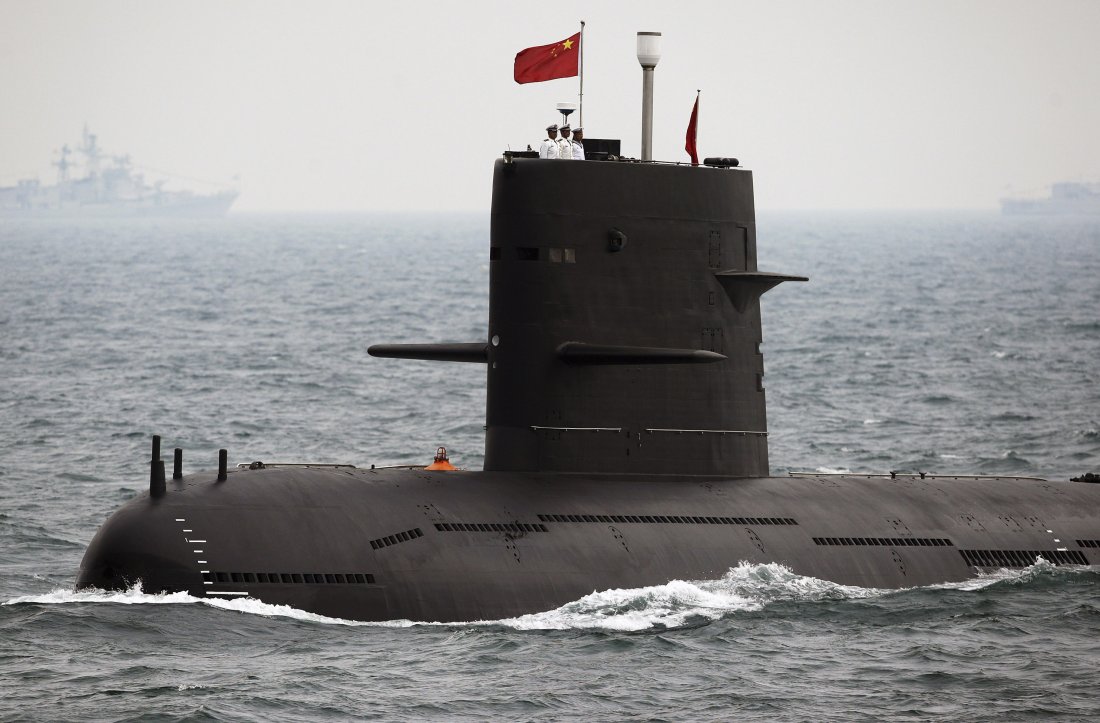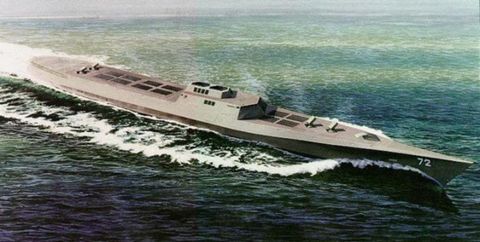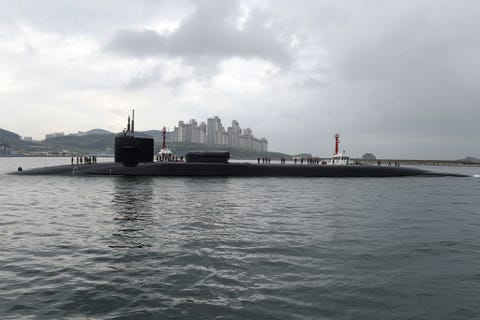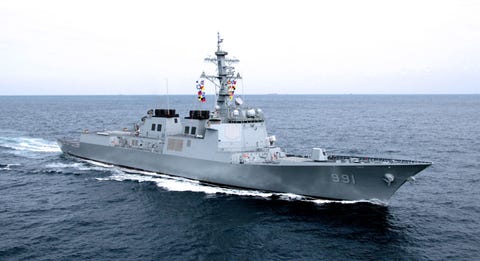- Joined
- Nov 29, 2016
- Messages
- 5,674
- Points
- 63
https://www.popsci.com/futuristic-chinese-warship-concept-is-making-waves
China is developing a warship of naval theorists' dreams
An arsenal ship that can be submerged in water.
By Jeffrey Lin and P.W. Singer posted Jun 1st, 2017 at 1:30pm

Arsenal Submarine
With distinctive twin conning towers, this arsenal ship can hide under the waves or move on the surface at higher speeds.
baoxiuyuan
The Chinese navy is taking arsenal ships in a new direction—as giant submersibles. Post-Cold War naval theorists have long dreamed of recreating the old battleships' power through massive "arsenal ships," or warships carrying hundreds of guided missiles that could fire at land and sea targets. Now it looks like China wants to make that dream a reality.

In Between the Tides and the Seabed
Professor Dong Wen Cai, the late Chinese hydrodynamics expert, shows a sketch of a submersible major combatant, with a flat hull and mid-hull steering fins.
CNTV
Stories circulating on Chinese websites—including the Wuhan city government site—mention that Chinese institutions are conducting studies on gigantic submersible arsenal ships.
What's the big deal about an underwater arsenal vessel? Well submerging all or even most of a large warship would reduce its radar and visual signature, as well as protect it against most missile threats.

CAD Waveskimmer
This computer-generated line drawing of the Chinese waveskimmer shows hull-mounted fins that allow for maneuverability and underwater (and semi-submerged) operation. It appears to also be capable of hydroplaning.
NSFC
There are two concepts in circulation: one is a high-speed warship with much of its hull submerged but otherwise has a functional superstructure with defense weapons and radar, the other is almost completely submerged arsenal ship with two conning towers. The scale of the designs are significant; either ship would displace roughly about 20,000 tons at full load.

Submersible Cruiser
The submersible warship has four stages: submerged, partial exposure of the superstructure, raising the hull to the 'waterline' and as a low draft, and operating as a high-speed hydroplane.
NSFC
Reports claim there has been substantial design work and concept proofing for this underwater arsenal ship. Even on his deathbed, leading naval engineer Professor Dong Wei Cai continued to work on a key aspect of the arsenal ship design: the high-speed wave hydroplane.
For stealth operations, the arsenal ship would have most of its hull inherently submerged, with only the bridge and a few other parts of the ship above the waterline, reducing the radar cross section. But when traveling with a high-speed naval taskforce, the arsenal ship will sacrifice stealth to use its flat hull bottom to hydroplane at high speeds, cutting across the waves like a speedboat or amphibious armored vehicle.

Carrier Group
An arsenal ship can rely on the carrier's airwing and surface warship escorts to protect it against airborne threats, while providing the carrier group hundreds of extra missile launchers holding anything from air-defense rockets to land-attack cruise missiles.
baoxiuyuan
The second design is more conventional, it is essentially a giant, conventionally propelled submarine with two conning towers stuffed with snorkels, periscopes, and communications antennae. Given its need to keep up with high-speed surface ships and its lack of high-speed endurance underwater, this arsenal ship design would operate similarly to WWII submarines; the majority of its voyage will take place on the surface, and will submerge only during combat and under attack.

Demonstrator
While a 4-meter-long, 1-ton scale model of the high-speed submersible has been undergoing tests and is even shown on state television, no complete picture of the demonstrator has been shown, with only partial photos being released to the public.
CCTV 7
Chinese research institutes have been testing sub-models of both arsenal ship configurations since 2011, including open-water tests for the hydroplane arsenal ship and laboratory tests for the arsenal submarine. Unverified rumors on the Chinese internet claim that a full-scale, proof-of-concept is under construction at Bohai Shipbuilding Heavy Industrial Corporation, to be launched after 2020.
You may also be interested in:
- China Is Building the World's Largest Nuclear Submarine Facility
- China's New Ballistic Missile Submarine Could Change its Prospects in Nuclear War
http://www.chinatopix.com/articles/...-developing-arsenal-warship-proposed-navy.htm
Science
China said to be Developing ‘Arsenal Warship’ Proposed by US Navy
By Arthur Dominic Villasanta | Jun 02, 2017 08:31 PM EDT
0

Concept for China's proposed arsenal submersible.

Proposed U.S. Navy arsenal ship. (Photo : US Navy)
The fantastic "arsenal ship" -- a surface warship packed with as many as 500 missiles almost built by the U.S. Navy two decades ago -- is allegedly being considered for development by China.
The Chinese have put one twist in their concept for an arsenal ship, however.
They intend their version of the arsenal ship to be a massive "submersible," which is a vessel that can submerge but spends most of its time on the surface.
Like Us on Facebook
One other but more controversial concept is developing a true arsenal submarine that stays submerged for most of its mission.
Posts on Chinese websites are saying Chinese research associations either owned by or associated with the government are conducting studies regarding the feasibility of these submersible or submerged arsenal warships. They claim there has been significant design work and concept proofing for this vessel.
The U.S. Navy version of the arsenal warship is a floating missile platform intended to have as many as 500 vertical launch bays for cruise missiles. The Navy wanted its arsenal ships to be unmanned robotic vessels operated by remote control.
First proposed in 1996, the arsenal warships would have used its missiles for shore bombardment in support of invading U.S. Marines. Congress scrapped funding for the project in 1998.
On the other hand, the Chinese are said to be looking at a high-speed submersible or submarine displacing some 20,000 tons. The submersible will feature two conning towers.
It will have four stages: submerged; partial exposure of the superstructure; raising the hull to the waterline and as a low draft and operating as a high-speed hydroplane.
To reduce its radar cross section, the arsenal submersible will have most of its hull submerged, with only the bridge and a few other parts of the ship above the waterline. When traveling with a carrier strike group, however, the arsenal submersible will use its flat hull bottom to hydroplane at high speeds.
Because it needs a surface warfare group for protection, an arsenal submersible will have to spend most of its mission on the surface and submerge when threatened, much the same mission profile as the Type VII and Type IX U-Boats of the Kriegsmarine (the German Navy) in World War II.
https://nationalinterest.org/blog/b...guided-missile-ship-and-plans-look-nuts-52272
 Subscribe
Subscribe
April 12, 2019 Topic: Security Region: Asia-Pacific Blog Brand: The Buzz Tags: ChinaPLA NavySouth China SeaU.S. NavyAttack Submarines
China May Build A Diving Guided-Missile Ship, And The Plans Look Nuts
Or Is this just fake news?
by Task and Purpose
The Chinese navy may be putting a new spin on a classic warship: It’s looking into the possibility of giving missile-laden arsenal ships submersible properties, enabling them to hide stockpiles of missiles, undetectable to radar, below the ocean surface.
The Chinese are exploring two arsenal-ship versions, according to Popular Science: One is a high-speed surface warship that can submerge at will, while the second is more similar to a traditional submarine.
This article originally appeared at Task & Purpose. Follow Task & Purpose on Twitter. This article first appeared in 2017.
9
seconds
Do You Know What Happened On This Day?
What could a submersible surface ship do that a conventional submarine can’t? It could go really fast on the surface, thanks to a hydroplaning hull, Popular Science reports:
For stealth operations, the arsenal ship would have most of its hull inherently submerged, with only the bridge and a few other parts of the ship above the waterline, reducing the radar cross section. But when traveling with a high-speed naval taskforce, the arsenal ship will sacrifice stealth to use its flat hull bottom to hydroplane at high speeds, cutting across the waves like a speedboat or amphibious armored vehicle.
The alternative plan calls for a platform that behaves similar to World War II submarines, Popular Science writes — typically staying at the surface, but able to completely submerge for stealth.
Two Chinese universities are responsible for the designing the concepts, according to the Wuhan city government. Those institutions, the Wuhan University of Science and Technology and Huazhong University of Science and Technology and Naval University of Engineering, were awarded a state prize for the work.
The concepts have been in the works since 2011, but anticipation is building. According to Popular Science, the diving missile ship’s “proof-of-concept is under construction at Bohai Shipbuilding Heavy Industrial Corporation, to be launched after 2020.”
More Articles from Task & Purpose:
- 7 Veteran-Friendly Manufacturers That Are Hiring
- The 6 Types Of Contractors You Encounter Overseas
- Here’s How Marines Fared On The New Physical Fitness Test
Image: Reuters.
https://www.nextbigfuture.com/2017/...oplaning-mode-and-submersible-capability.html
China developing arsenal ship that would have a high speed hydroplaning mode and submersible capability
Brian Wang | June 3, 2017

0
Reports claim there has been substantial design work and concept proofing for a new underwater arsenal ship in China. A leading chinese naval engineer Professor Dong Wei Cai continued to work on a key aspect of the arsenal ship design: the high-speed wave hydroplane up until his recent death.
There are two concepts in circulation:
1. a high-speed warship with much of its hull submerged but otherwise has a functional superstructure with defense weapons and radar
2. other is almost completely submerged arsenal ship with two conning towers.
Both ship designs could displace roughly about 20,000 tons at full load.

publicly that recognizes the value. They
bring to their company value. They bring
Recommend a Friend and Reap the Benefits
Sponsored by Connatix
These warships could carry hundreds of guided missiles.
The arsenal ship would have most of its hull inherently submerged, with only the bridge and a few other parts of the ship above the waterline which reduce the radar cross section. This would be in situations where the ship is hiding or trying to protect itself.
But when traveling with a high-speed naval taskforce, the arsenal ship will sacrifice stealth to use its flat hull bottom to hydroplane at high speeds, cutting across the waves like a speedboat or amphibious armored vehicle.

Sponsored Content
https://www.popularmechanics.com/military/navy-ships/a26772/china-arsenal-ship/
China is Developing Its Own Deadly "Arsenal Ship"
Ships and submarines would carry hundreds of missiles.

By Kyle Mizokami
Jun 5, 2017

A new article in Popular Science points to evidence that China is developing a so-called "arsenal ship," a large surface ship or submarine capable of carrying hundreds of missiles. Such a ship could allow the People's Liberation Army Navy to rapidly increase firepower without an investment in large numbers of expensive aircraft carriers, cruisers, and destroyers.
The U.S. developed the arsenal ship concept in the 1990s for the same kind of reason. Arsenal ships would be huge—based on supertanker or container ship hulls, and with a minimal crew. An arsenal ship would have hundreds if not thousands of Mark 41 vertical launch missile silos, each of which could carry a Tomahawk land attack cruise missile, SM-2 air defense missile, SM-3 ballistic missile interceptor, or future missile designs. A single ship could launch hundreds of cruise missiles against an enemy target, raining down destruction that was previously only possible by aircraft carriers.
The concept went nowhere with the U.S., however, because the Navy faced no serious competitors on the high seas and the ships were of no value in the conflicts in Iraq and Afghanistan. Apparently however, someone has decided that it's just the trick for a rapidly expanding navy to quickly add firepower.
According to Popular Science, China is working on two designs: a conventional arsenal ship and a submarine version. Each weighs in at approximately 20,000 tons. Currently, the surface ships with the largest number of missile-firing silos are South Korea's Sejong the Great guided missile destroyers, each of which displaces 11,000 tons and has 128 silos. Assuming the Chinese Arsenal Ship is twice as large and deletes the 5-inch deck gun, helicopter hangar, and flight deck, it could carry 300 or more missile silos.
According to unverified Chinese Internet rumors, a full-scale proof-of-concept ship will be launched after 2020. It seems unusual to go through the trouble of building an experimental ship hundreds of feet long that would not eventually become fully operational.

The guided missile submarine USS Michigan, which can carry up to 154 cruise missiles, pulling into Busan, South Korea, April 2017.
U.S. Navy photo by Mass Communication Specialist 2nd Class Jermaine Ralliford
A submarine version would be similar in size to the four 18,000 ton Ohio-class ballistic missile submarines. First fielded in 2002, the Ohio cruise missile submarines were modified to carry 154 Tomahawk cruise missiles. A 20,000 ton submarine purpose-built to carry missile silos might have up to 200 of them.
Arsenal ships are one-trick ponies designed to do one thing well: launch a lot of missiles at a single target, whether that target is an enemy country or fleet. They can't conduct anti-piracy missions, or anti-submarine warfare missions, or even fight on their own. They are designed to operate as part of a larger naval task force, with the ships and aircraft of that task force providing targeting information and protection from threats.

ROKS Sejong the Great, which has more vertical launch missile silos than U.S. Navy cruisers and destroyers.
Wikipedia photo.
Arsenal ships aren't for everyone. A navy that operates worldwide—and whose ships may be called on to perform three or four completely different types of missions during the course of a six-month cruise—will find an arsenal ship is less useful. But for a burgeoning navy that wants to keep potential enemies out of the South China Sea, an arsenal ship represents an inexpensive way to boost the fleet's missile-firing capabilities quickly and relatively cheaply.
